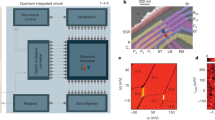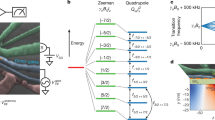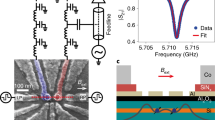Abstract
Detection of nuclear spin precession is critical for a wide range of scientific techniques that have applications in diverse fields including analytical chemistry, materials science, medicine and biology. Fundamentally, it is possible because of the extreme isolation of nuclear spins from their environment. This isolation also makes single nuclear spins desirable for quantum-information processing, as shown by pioneering studies on nitrogen-vacancy centres in diamond1,2,3,4. The nuclear spin of a 31P donor in silicon is very promising as a quantum bit5: bulk measurements indicate that it has excellent coherence times6,7 and silicon is the dominant material in the microelectronics industry. Here we demonstrate electrical detection and coherent manipulation of a single 31P nuclear spin qubit with sufficiently high fidelities for fault-tolerant quantum computing8. By integrating single-shot readout of the electron spin9 with on-chip electron spin resonance10, we demonstrate quantum non-demolition11 and electrical single-shot readout of the nuclear spin with a readout fidelity higher than 99.8 per cent—the highest so far reported for any solid-state qubit. The single nuclear spin is then operated as a qubit by applying coherent radio-frequency pulses. For an ionized 31P donor, we find a nuclear spin coherence time of 60 milliseconds and a one-qubit gate control fidelity exceeding 98 per cent. These results demonstrate that the dominant technology of modern electronics can be adapted to host a complete electrical measurement and control platform for nuclear-spin-based quantum-information processing.
This is a preview of subscription content, access via your institution
Access options
Subscribe to this journal
Receive 51 print issues and online access
$199.00 per year
only $3.90 per issue
Buy this article
- Purchase on Springer Link
- Instant access to full article PDF
Prices may be subject to local taxes which are calculated during checkout




Similar content being viewed by others
References
Jelezko, F. et al. Observation of coherent oscillation of a single nuclear spin and realization of a two-qubit conditional quantum gate. Phys. Rev. Lett. 93, 130501 (2004)
Neumann, P. et al. Single-shot readout of a single nuclear spin. Science 329, 542–544 (2010)
Maurer, P. C. et al. Room-temperature quantum bit memory exceeding one second. Science 336, 1283–1286 (2012)
Pfaff, W. et al. Demonstration of entanglement-by-measurement of solid-state qubits. Nature Phys. 9, 29–33 (2013)
Kane, B. E. A silicon-based nuclear spin quantum computer. Nature 393, 133–137 (1998)
Steger, M. et al. Quantum information storage for over 180 s using donor spins in a 28Si ‘semiconductor vacuum’. Science 336, 1280–1283 (2012)
Morton, J. J. L. et al. Solid-state quantum memory using the 31P nuclear spin. Nature 455, 1085–1088 (2008)
Knill, E. Quantum computing with realistically noisy devices. Nature 434, 39–44 (2005)
Morello, A. et al. Single-shot readout of an electron spin in silicon. Nature 467, 687–691 (2010)
Pla, J. J. et al. A single-atom electron spin qubit in silicon. Nature 489, 541–545 (2012)
Braginsky, V. B., Khalili, F. & Ya Quantum nondemolition measurements: the route from toys to tools. Rev. Mod. Phys. 68, 1–11 (1996)
Nielsen, M. A. & Chuang, I. L. Quantum Computation and Quantum Information (Cambridge Univ. Press, 2000)
Myerson, A. H. et al. High-fidelity read-out of trapped-ion qubits. Phys. Rev. Lett. 100, 200502 (2008)
Brown, K. R. et al. Single-qubit-gate error below 10−4 in a trapped ion. Phys. Rev. A 84, 030303(R) (2011)
Clarke, J. & Wilhelm, F. K. Superconducting quantum bits. Nature 453, 1031–1042 (2008)
Hanson, R. & Awschalom, D. D. Coherent manipulation of single spins in semiconductors. Nature 453, 1043–1049 (2008)
Becker, P., Pohl, H. J., Riemann, H. & Abrosimov, N. Enrichment of silicon for a better kilogram. Phys. Status Solidi A 207, 49–66 (2010)
McCamey, D. R., Van Tol, J., Morley, G. W. & Boehme, C. Electronic spin storage in an electrically readable nuclear spin memory with a lifetime > 100 seconds. Science 330, 1652–1656 (2010)
Vincent, R., Klyatskaya, S., Ruben, M., Wernsdorfer, W. & Balestro, F. Electronic read-out of a single nuclear spin using a molecular spin transistor. Nature 488, 357–360 (2012)
Morello, A. et al. Architecture for high-sensitivity single-shot readout and control of the electron spin of individual donors in silicon. Phys. Rev. B 80, 081307(R) (2009)
Jamieson, D. N. et al. Controlled shallow single-ion implantation in silicon using an active substrate for sub-20-keV ions. Appl. Phys. Lett. 86, 202101 (2005)
Angus, S. J., Ferguson, A. J., Dzurak, A. S. & Clark, R. G. Gate-defined quantum dots in intrinsic silicon. Nano Lett. 7, 2051–2055 (2007)
Steger, M. et al. Optically-detected NMR of optically-hyperpolarized 31P neutral donors in 28Si. J. Appl. Phys. 109, 102411 (2011)
Feher, G. Electron spin resonance experiments on donors in silicon. I. Electronic structure of donors by the electron nuclear double resonance technique. Phys. Rev. 114, 1219–1244 (1959)
Dehollain, J. P. et al. Nanoscale broadband transmission lines for spin qubit control. Nanotechnology 24, 015202 (2013)
Pines, D., Bardeen, J. & Slichter, C. P. Nuclear polarization and impurity-state spin relaxation processes in silicon. Phys. Rev. 106, 489–498 (1957)
Dreher, L., Hoehne, F., Stutzmann, M. & Brandt, M. S. Nuclear spins of ionized phosphorus donors in silicon. Phys. Rev. Lett. 108, 027602 (2012)
Witzel, W. M., Carroll, M. S., Cywinski, Ł. & Das Sarma, S. Quantum decoherence of the central spin in a sparse system of dipolar coupled spins. Phys. Rev. B 86, 035452 (2012)
Mehring, M., Mende, J. & Scherer, W. Entanglement between an electron and a nuclear spin 1/2. Phys. Rev. Lett. 90, 153001 (2003)
Simmons, S. et al. Entanglement in a solid-state spin ensemble. Nature 470, 69–72 (2011)
Acknowledgements
We thank R. P. Starrett, D. Barber, C. Y. Yang and R. Szymanski for technical assistance and A. Laucht, R. Kalra and J. Muhonen for discussions. This research was funded by the Australian Research Council Centre of Excellence for Quantum Computation and Communication Technology (project number CE11E0096) and the US Army Research Office (W911NF-13-1-0024). We acknowledge support from the Australian National Fabrication Facility.
Author information
Authors and Affiliations
Contributions
K.Y.T. and W.H.L. fabricated the device; D.N.J. designed the P implantation experiments; J.J.P., K.Y.T., J.J.L.M., J.P.D. and F.A.Z. performed the measurements; J.J.P., A.M., A.S.D. and J.J.L.M. designed the experiments and discussed the results; J.J.P. and A.M. analysed the data; and J.J.P. and A.M. wrote the manuscript with input from all co-authors.
Corresponding author
Ethics declarations
Competing interests
The authors declare no competing financial interests.
Supplementary information
Supplementary Information
This file contains supplementary Text and Data 1-8, Supplementary Figures 1-4 and additional references. (PDF 656 kb)
Rights and permissions
About this article
Cite this article
Pla, J., Tan, K., Dehollain, J. et al. High-fidelity readout and control of a nuclear spin qubit in silicon. Nature 496, 334–338 (2013). https://doi.org/10.1038/nature12011
Received:
Accepted:
Published:
Issue Date:
DOI: https://doi.org/10.1038/nature12011
This article is cited by
-
Navigating the 16-dimensional Hilbert space of a high-spin donor qudit with electric and magnetic fields
Nature Communications (2024)
-
High-fidelity initialization and control of electron and nuclear spins in a four-qubit register
Nature Nanotechnology (2024)
-
Qubit-controlled directional edge states in waveguide QED
npj Quantum Information (2023)
-
Compilation and scaling strategies for a silicon quantum processor with sparse two-dimensional connectivity
npj Quantum Information (2023)
-
Noisy intermediate-scale quantum computers
Frontiers of Physics (2023)
Comments
By submitting a comment you agree to abide by our Terms and Community Guidelines. If you find something abusive or that does not comply with our terms or guidelines please flag it as inappropriate.



